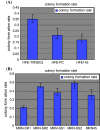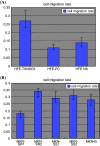The influence of TXNDC5 gene on gastric cancer cell
- PMID: 20157732
- PMCID: PMC11827854
- DOI: 10.1007/s00432-010-0807-x
The influence of TXNDC5 gene on gastric cancer cell
Abstract
Background: TXNDC5 (thioredoxin domain containing 5) is over-expressed in tumors of the cervix, uterus, stomach and lung. However, not much is known about the functional roles of TXNDC5 gene in gastric adenocarcinoma. In the present study, we intend to investigate the effects of TXNDC5 on the growth, proliferation, apoptosis, invasion and cell cycle of the gastric cancer cell line MKN45 and normal gastric cell line HFE145.
Methods: TXNDC5 cDNA was inserted into a constitutive vector pcDNA3.1 followed by transfection into normal gastric cell line HFE145 using liposome. Then, stable transfectants were selected and appraised. Specific silencing of TXNDC5 gene was achieved using a vector-based short interference RNAs (siRNA) system in gastric cancer cell line MKN45. The growth and proliferation were analyzed by cell growth curves and colony-forming assay, respectively. The apoptosis and cell cycles of these clones were analyzed using flow cytometry. The invasion of these cells was analyzed by cell migration assay. The TXNDC5 stable expression cell lines (HFE-TXNDC5) and TXNDC5 RNAi cell lines (MKN-SR1,2) were detected and compared with their control groups, respectively.
Results: HFE-TXNDC5 grew faster than HFE145 and HFE-PC(HFE145 transfected with pcDNA3.1 vector). MKN-SR1 grew slower than MKN45 and MKN-SS1,2 (MKN45 transfected with scrambled control duplexes). The cell counts of HFE-TXNDC5 in the fifth, sixth and seventh days were significantly higher than those of control groups (P < 0.05). The cell counts of MKN-SR1 in the fifth, sixth and seventh days were significantly lower than those of control groups (P < 0.05). Cell cycle analysis showed that there were significant differences in proportions of G0-G1 and G2-M phase between HFE-TXNDC5, MKN-SR1 cells and their control groups, respectively (P < 0.05). The apoptosis rate of HFE-TXNDC5 was significantly lower than that of control groups (P < 0.05). The results of colony-forming assay showed that the colony formation rate of HFE-TXNDC5 was higher than those of control groups, otherwise the rate of MKN-SR1 were lower than those of their control groups (P < 0.05). The results of cell migration assay showed that the migration rate of HFE-TXNDC5 were significantly higher than that of its control group. Conversely, the migration rate of MKN-SR1 was significantly lower than that of its control group (P < 0.05).
Conclusion: TXNDC5 can promote the growth and proliferation of gastric cells. Silencing of TXNDC5 can restrain the growth and proliferation of gastric cancer cells. The gene can enhance the capability of invasion of gastric cancer cells. In some respects, TXNDC5 could be thought as a tumor-enhancing gene in gastric cancer.
Figures









Similar articles
-
A study on the functions of ubiquitin metabolic system related gene FBG2 in gastric cancer cell line.J Exp Clin Cancer Res. 2009 Jun 10;28(1):78. doi: 10.1186/1756-9966-28-78. J Exp Clin Cancer Res. 2009. PMID: 19515249 Free PMC article.
-
The impact of C-MYC gene expression on gastric cancer cell.Mol Cell Biochem. 2010 Nov;344(1-2):125-35. doi: 10.1007/s11010-010-0536-0. Epub 2010 Aug 25. Mol Cell Biochem. 2010. PMID: 20737197 Free PMC article.
-
Impact of BTG2 expression on proliferation and invasion of gastric cancer cells in vitro.Mol Biol Rep. 2010 Jul;37(6):2579-86. doi: 10.1007/s11033-009-9777-y. Epub 2009 Sep 2. Mol Biol Rep. 2010. PMID: 19728149
-
Sertindole for schizophrenia.Cochrane Database Syst Rev. 2005 Jul 20;2005(3):CD001715. doi: 10.1002/14651858.CD001715.pub2. Cochrane Database Syst Rev. 2005. PMID: 16034864 Free PMC article.
-
The Black Book of Psychotropic Dosing and Monitoring.Psychopharmacol Bull. 2024 Jul 8;54(3):8-59. Psychopharmacol Bull. 2024. PMID: 38993656 Free PMC article. Review.
Cited by
-
LncRNA-ENST00000556926 regulates the proliferation, apoptosis and mRNA transcriptome of malignant-transformed BEAS-2B cells induced by coal tar pitch.Toxicol Res (Camb). 2021 Nov 6;10(6):1144-1152. doi: 10.1093/toxres/tfab097. eCollection 2021 Dec. Toxicol Res (Camb). 2021. PMID: 34956617 Free PMC article.
-
Role of TXNDC5 in tumorigenesis of colorectal cancer cells: In vivo and in vitro evidence.Int J Mol Med. 2018 Aug;42(2):935-945. doi: 10.3892/ijmm.2018.3664. Epub 2018 May 9. Int J Mol Med. 2018. PMID: 29749460 Free PMC article.
-
Squalene Loaded Nanoparticles Effectively Protect Hepatic AML12 Cell Lines against Oxidative and Endoplasmic Reticulum Stress in a TXNDC5-Dependent Way.Antioxidants (Basel). 2022 Mar 18;11(3):581. doi: 10.3390/antiox11030581. Antioxidants (Basel). 2022. PMID: 35326231 Free PMC article.
-
Protein Disulfide Isomerases Function as the Missing Link Between Diabetes and Cancer.Antioxid Redox Signal. 2022 Dec;37(16-18):1191-1205. doi: 10.1089/ars.2022.0098. Epub 2022 Nov 21. Antioxid Redox Signal. 2022. PMID: 36000195 Free PMC article. Review.
-
The redox regulator sulfiredoxin forms a complex with thioredoxin domain-containing 5 protein in response to ER stress in lung cancer cells.J Biol Chem. 2019 May 31;294(22):8991-9006. doi: 10.1074/jbc.RA118.005804. Epub 2019 Apr 18. J Biol Chem. 2019. PMID: 31000628 Free PMC article.
References
-
- Arber N, Shapira I, Ratan J, Stern B, Hibshoosh H, Moshkowitz M, Gammon M, Fabian I, Halpern Z (2000) Activation of c-K-ras mutations in human gastrointestinal tumors. Gastroenterology 118:1045–1050 - PubMed
-
- Calcagno DQ, Leal MF, Seabra AD, Khayat AS, Chen ES, Demachki S, Assumpcao PP, Faria MH, Rabenhorst SH, Ferreira MV, de Arruda Cardoso Smith M, Burbano RR (2006) Interrelationship between chromosome 8 aneuploidy, C-MYC amplification and increased expression in individuals from northern Brazil with gastric adenocarcinoma. World J Gastroenterol 12:6207–6211 - PMC - PubMed
-
- Claudio JO, Masih-Khan E, Tang H, Gonçalves J, Voralia M, Li ZH, Nadeem V, Cukerman E, Francisco-Pabalan O, Liew CC, Woodgett JR, Stewart AK (2002) A molecular compendium of genes expressed in multiple myeloma. Blood 100(6):2175–2186 - PubMed
-
- Clissold PM, Bicknell R (2003) The thioredoxin-like fold: hidden domains in protein disulphide isomerases and other chaperone proteins. Bioessays 25:603–611 - PubMed
-
- Correa P (1992) Human gastric carcinogenesis: a multistep and multifactorial process—First American Cancer society Award Lecture on Cancer Epidemiology and Prevention. Cancer Res 52:6735–6740 - PubMed
MeSH terms
Substances
LinkOut - more resources
Full Text Sources
Medical

